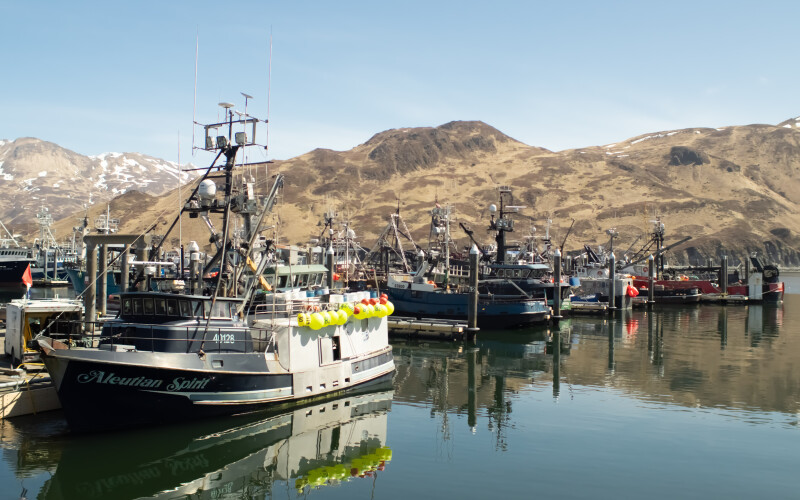Some fishing towns have a way of getting under your skin. You land there by boat or by plane, and their docks, pilings, and weathered streets could pass for any other port in Alaska. But a few hours after you’ve settled in their details, you can differentiate them all others.
I’m walking in the mud at the side of the main drag through Dutch Harbor and following what appears to be a herd of others whose boots lay the selfsame tracks and lugged sole patterns as my own: Xtratufs. Sure, the knee-high, brown rubber boots have won ubiquity on the fashion front across the globe, but I quickly discern that these are not the tracks of tourists. Their deliberate strides indicate they belong to diehard crabbers, longliners, and draggers, who in the absence of other transportation, are hoofing it to the stores, the banks or the bars.
There is a hum to Dutch like no other seaport I’ve known. Semi tractor-trailer rigs constantly roll through the intersections as they shuttle containers of frozen who-knows-what to the docks, where a giant crane loads them a dozen layers deep onto a tramper hailing out of Singapore.
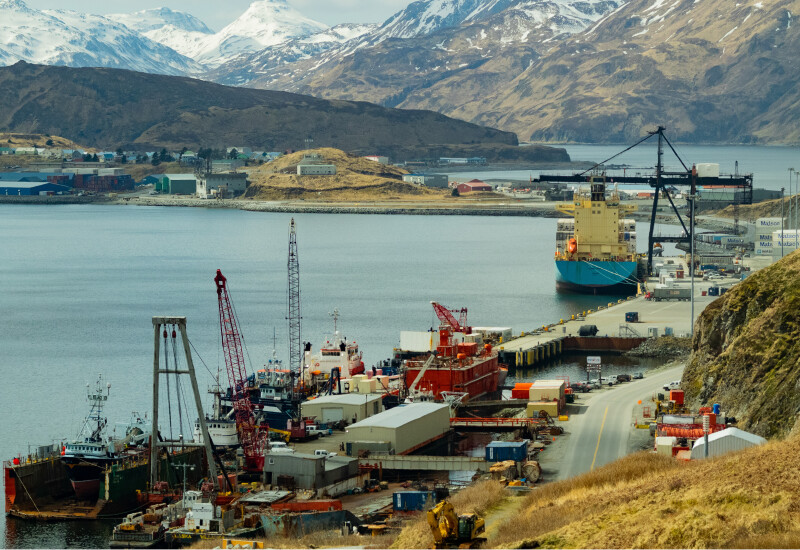
The incessant reverse gear warning buzzers, beepers, squawkers, and squealers of forklifts, trucks, tractors, loaders, cranes, and other equipment leave me wondering if anyone here drives in forward. Somehow, the piercing chirps of bald eagles cut through the din as they proclaim temporary ownership of street lamps, pilings, and garbage dumpsters throughout the town.
More than 400 boats lay tied up in three harbors and a dozen other docks in town. I’m trying to estimate the number of containers that move from this port to everywhere else in the world. Crab (until recently). Pollock. Cod. Halibut. Sole. Blackcod. Herring. Bottomfish of every kind. For the past 23 years, Dutch has ranked number one in the nation among seafood ports, with annual landings of 763 million pounds. The port takes second in the nation in terms of value at $190 million.
Then it hits me. A light northeast day breeze stirs the glass-calm waters within the port of Dutch Harbor to a textured indigo blanket with whitecaps here and there. The sun is shining. The scent of sun-dried kelp and salt on the rocks immediately takes me back to the 16 summers I spent gill netting salmon a few islands north of here. As I walk along the beach, my footsteps fall into cadence with the waves, and my emotional odometer rolls back 28 years to a time when the beauty of this country held me in its grip, and I had the muscle to make a go of it. As it turns out, these aren’t the only familiar connections I’ll uncover here in Dutch.
The Aleutians. The Far West. The Wild West. Out West. Home of the TV show, “Deadliest Catch.” Everyone comes for the money. Most loathe the place for the lack of trees. Some find it alluring for a few transient years, and only a smattering of folks to set foot on the docks in Dutch ever put down roots and call it home.
We’re sipping French-pressed coffee in the kitchen of the tidy beach house owned by Peter Neaton. The place was built sometime in the 1930s, restored some by earlier owners, and he spends time clearing the lot of debris and puttering with outdoor light fixtures around the place.
“This is my money pit,” he says. “This is my passion project.”
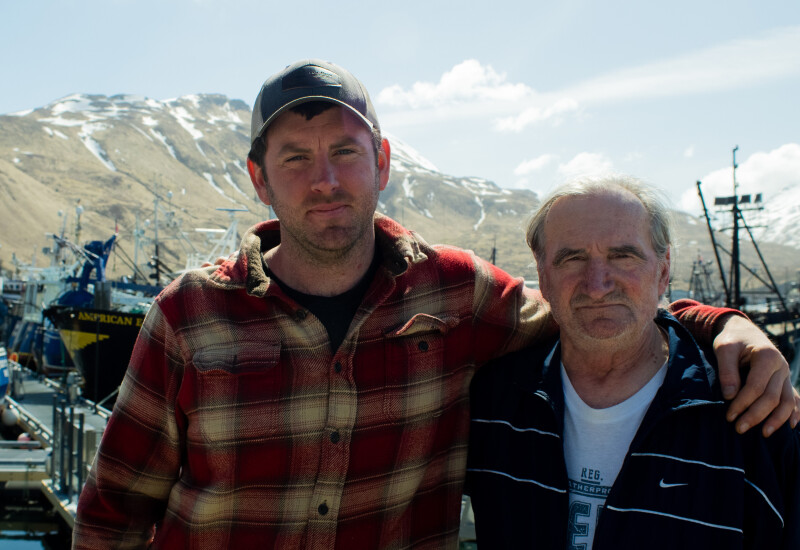
As for how he got here – and stays here, Neaton, 34, met Claire Laukitis, the woman who would later become his wife, while attending college in Vermont. When he heard that her father owned fishing boats in Alaska, he hired on as a crew member during the salmon seine season. The boat, Stanley K, fished in the Shumagin Islands north of Dutch that year, and the season was a bust.
“I didn’t know anything,” says Neaton, who grew up a sheep farm in Minnesota. “I didn’t know what a good catch was supposed to look like. Nobody was catching anything.”
In an effort to salvage the season financially, the skipper of the boat steamed several hundred miles south, hoping to load up on pink salmon north of Dutch. But that was also a bust; so the skipper decided to tie up in town for a few days.
“I had been to Sand Point, King Cove, False Pass, and I’d been to Homer,” says Neaton. “We came around here and saw all these lights, and I wondered, what is this place? There was just so much activity, and I thought, this seems like a place where a guy could make a lot of money. So I always kept in the back of my mind as a place I’d come back to.”
Money, yes. But he could have bought a house anywhere. With part ownership in Oracle and the Halcyon, two 58-foot Fred Wahl, “Super 8’s” that fish cod, salmon, halibut and blackcod in the nearshore waters of the entire state, Neaton spends a portion of the year tied up in at least nine other ports. But this house in Dutch is home.
“Oh, I love it here,” he says.
We’re hovering near a hot woodstove, staring through his living room windows at the blue water of the bay.
“Look at how close we are to the water.”
For the moment we are mesmerized by the waves lapping the shore. We acknowledge over a cup of coffee how the Aleutians have a way of gripping a select few of us. I learned just hours before meeting Neaton that he and I were born in the same small town, Watertown, Minn.
While it may be complimentary genetic glitches that drive Neaton and I to favor the windswept beaches and volcanic promontories of the Aleutians over the rolling hills and hardwood forests of Minnesota, a DUI in Arizona brought Charlie Gaspar to Dutch.
Gaspar, 67, originally hails from Hungary, and his drinking days as a cabbie cost him his operator’s license in Phoenix some years ago. He came to Anchorage for a fresh start, and drove a cab for a few months but smelled the lure of money that could be found in fishing. He saved up some cash, went to Kodiak, got on a boat, the Steadfast, and eventually wound up working the back decks of the Stanley K and many others here in Dutch.
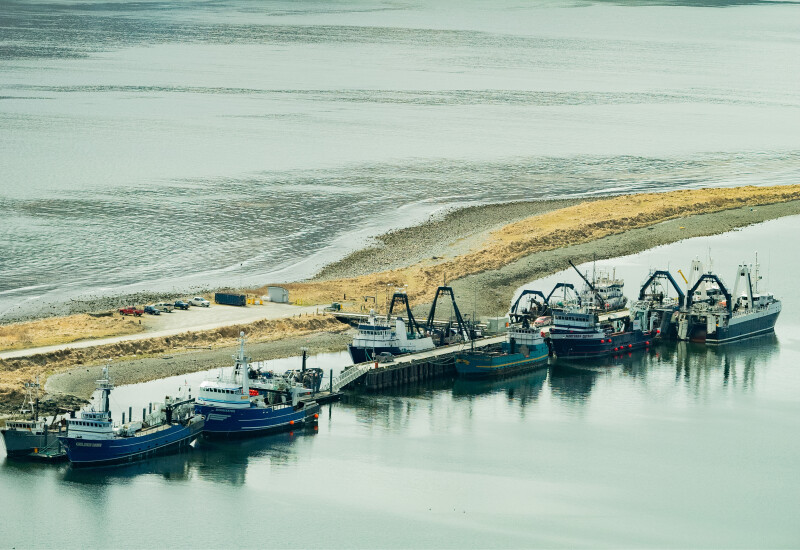
These days he owns a small house in Dutch. He and his wife Rowena run their two taxi vans when he’s not out hauling longline gear for halibut and blackcod or pulling pots for cod. He talks about hanging it up, that last year’s trips at sea will be his last, but there is a lack of conviction in his voice as he looks out over the water on a sunny afternoon when Neaton and I pile into his taxi for a drive out to the end of Captains Bay. The meter is running, and charges are ticking past $14, but there won’t be any money exchanged as currency of the day is stories.
We’re weighing in, the three of us, recalling our favorite and most perilous times on the water and trying to define what it is that draws us here, to this place we affectionately call Dutch.
Neaton likes salmon seining, tendering, and hauling pots for cod. Meanwhile, salmon gill netting on nearby Unimak Island tops the list for me.
“Opies,” says Gaspar in his thick Hungarian accent.
“Opies?” I ask. His response would have held greater surprise had not Neaton hinted earlier of Gaspar’s penchant for challenges at sea. Most deckhands through the years dread the excruciating hard work of opie seasons, the prerequisite to earning their employment on the boats during the more lucrative king crab seasons.
“Why opies?” I’m half expecting a joke.
“Because it’s hard, you know,” he says. “It’s tough. You’ve got to be very very good. You’ve got to be strong to finish out the season.”
Neaton and I agree that Gaspar may have struck upon a common strand that defines our love for this place. With its fetch from the northwest running all the way to Russia and with the Pacific open past the equator to its south, its incessant gales, freezing spray, sleet, and monster waves ensure that fishing – and life – will never be easy here. Harsh for some, but for others, the big water and the 1,100-mile string of islands hold allure, perhaps as a place to prove ourselves.
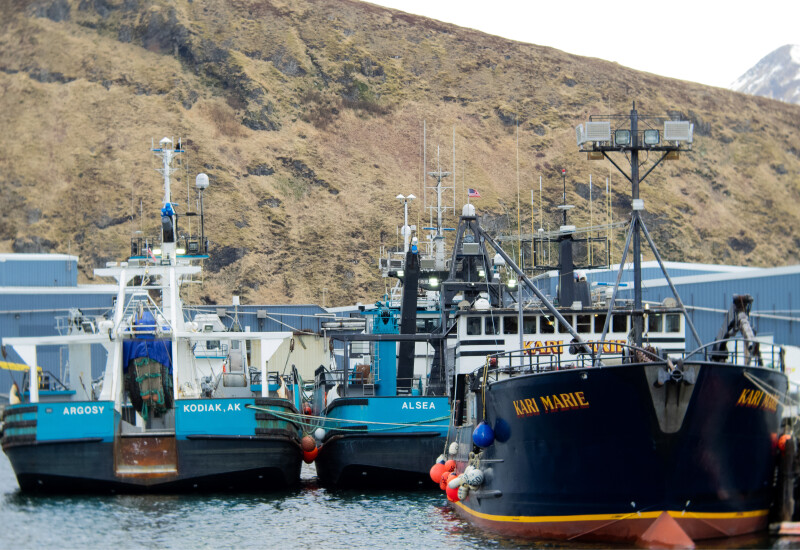
“It’s beautiful here,” Gaspar suddenly adds.
Make that a beautiful place in which to prove ourselves, a place to embrace. For those with a sense of adventure and a love for fishing, big money, big water, and volcanic vistas, Dutch Harbor will always be home.





